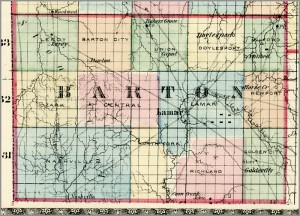Barton County, Missouri

- Formed: 1857
- County Population 1860: 1,817
- Slave Population 1860: 21
- Civil War Engagements-Suffered constant guerrilla warfare
Image courtesy of Wilson’s Creek National Battlefield
Barton County, Missouri is located on the Missouri-Kansas border. It has many sources of fresh water including the Sac, White, and Osage Rivers, Coon, Horse, Little and Big Drywood, Duval, West Fork, and Muddy Creeks. Farmers cultivated corn, grazing grasses, fruits, and vegetables. There area also contained natural iron ore and coal deposits, which are very important to local industry. Timber resources include elm, hickory, oak, and walnut, and building stones include limestone and sandstone.
Originally Osage territory, Barton County’s first non-Native American settler was Allen Petty. Other early settlers included George E. Ward, Charles VanPelt, David Norris, and John Apperson. The county was officially established in 1857 from parts of Jasper County, and Allen Petty, the first county commissioner, chose the county seat at Lamar. Barton County was named after Daniel Barton, a United States Congressman from Missouri. The county court established seven townships. These were: Newton, Union, Mineral, Nashville, Lamar, North Fort, and Golden Grove. George E. Ward opened the first store, and other towns, including Liberal and Golden City, were soon established. Because Barton County borders Kansas, residents were deeply involved in the 1850s debate aver Kansas’ entry into the Union as a free or slave state. Residents commonly conducted raids back and forth across state lines.
As the Barton County population was only 1,817 in 1860, due to its formation only three years prior, the number of men who fought in the Civil War was relatively small compared to other Missouri Counties. Residents’ sympathies with the Union and the Confederacy were roughly evenly divided. Border warfare was a constant plague on the residents, and many fled to surrounding counties that were not directly on the Kansas-Missouri border. Though the population fluctuated, estimates from this period show that there were hardly ever any more than six families remaining in the county at any one time during the war.
Barton County men were members of several military outfits, including Confederate troops Major Randall and Barton County native Lieutenant A.J. Smith. Other regiments, mostly Union, included: Company F, 18th Missouri Infantry, Company A, 6th Missouri Cavalry, Company A, 25th Missouri Infantry, Company I, 3rd Missouri Cavalry, Companies C, B, A, and G, 7th Missouri Cavalry, Company A, 2nd Missouri Infantry, Company E, 14th Missouri State Militia, Company A, 4th Missouri State Militia, Company I, 10th Missouri State Militia, and the 46th Missouri State Militia. There were no major battles in Barton County boundaries, though Barton County men fought in the Battle of Wilson’s Creek in Greene County and the Battle of Dug Springs in Christian County. Barton County suffered constantly from guerrilla warfare, Jayhawkers from Kansas and Bushwhackers from Missouri. These guerrillas burned and destroyed property and arbitrarily shot residents who remained in the county during the war. Prominent resident George Ward was killed by Bushwhackers in this way, and his and every other business ceased operations until the war was over.
After the war, the county remained sharply divided for several years, and many families did not return to the area. Those that did return began to rebuild their lives. A coal mining operation began, bringing more people and the railroad to the area, and in 1870 the population was 5,087 people. The town of Minden Mines was formed in 1885 around the coal and railroad operation.
 Browse all collections in Barton County
Browse all collections in Barton County
- Consulted:
- History of Polk, Cedar, Dade, and Barton Counties, Missouri (Greeneville, SC: Southern Historical Press, Inc., 2002).












